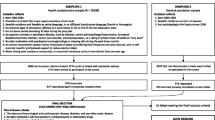Abstract
Objectives. Vital exhaustion, a construct overlapping with burnout, is an independent risk factor for adverse health outcomes, including cardiovascular disease. We aimed to assess vital exhaustion in employees in the manufacturing industry and identify work characteristics associated with exhaustion.
Methods. Cross-sectional study. A stratified, representative random sample of employees from a manufacturing plant for airplane parts and assemblies was invited (n=647), of whom 537 employees (83% accrual) volunteered to participate. Scores obtained by the nine-item Shortened Maastricht Exhaustion Questionnaire were compared with the mental and physical summary scales of the SF-12 General Health Survey and to a list of 20 health complaints. Pathogenic and salutogenic work characteristics were assessed by the self-reported 52-item, 13-subscale SALSA questionnaire.
Results. Vital exhaustion correlated with the mental summary score of the SF-12 and the number of health complaints and was positively associated with age. Exhaustion was not associated with gender, position (socio-economic status) or being on a wage (paid per completed item up to a contracted amount) or salary (payment as fixed monthly income). The instrument identified departments with high levels of exhaustion. Of the observed variance in exhaustion, 29% was explained by age, department, and five work characteristics: High levels of exhaustion (score >10) were related to excessive workload or qualitative demands (scoring in the highest quartile; ORadj 7.5; 95% CI 2.4–23), to adverse physical work conditions (ORadj 6.9; 95% CI 2.2–21), to adverse co-worker behavior (ORadj 4.8; 95% CI 1.4–16), to qualification potential (ORadj 0.32; 95% CI 0.11–0.97), and to social support by co-workers (ORadj 0.34; 95% CI 0.13–0.99), respectively.
Conclusions. The nine-item instrument allows rapid screening of employees for self-reported levels of exhaustion. Besides physical work conditions and workload, absence or presence of social support by co-workers is strongly associated with exhaustion.
Similar content being viewed by others
Author information
Authors and Affiliations
Additional information
Electronic Publication
Rights and permissions
About this article
Cite this article
Schnorpfeil, P., Noll, A., Wirtz, P. et al. Assessment of exhaustion and related risk factors in employees in the manufacturing industry – a cross-sectional study. Int Arch Occup Environ Health 75, 535–540 (2002). https://doi.org/10.1007/s00420-002-0369-6
Received:
Accepted:
Issue Date:
DOI: https://doi.org/10.1007/s00420-002-0369-6




